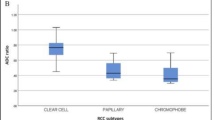Abstract
Purpose
To evaluate the ability of dynamic contrast-enhanced (DCE) 3-T MRI for preoperative differentiation between benign and malignant renal tumors and RCC subtypes.
Methods
Sixty consecutive patients undergoing preoperative DCE 3-T MRI of the kidney were evaluated in this retrospective IRB-approved evaluation. Fifty-four malignant tumors and 17 benign tumors upon surgical verification were included. Relative enhancement values of complete lesions and the most enhancing part of the lesions (hotspot) were measured using four repetitions: precontrast, arterial, venous, and delayed.
Results
Mean relative enhancement patterns between malignant and benign lesions did not differ significantly during any postcontrast phase (p > 0.05). The highest mean enhancement during all postcontrast phases was identified in clear cell RCC followed by chromophobic RCC. The enhancement pattern in papillary RCC was significantly less than that of non-papillary RCC lesions. Arterial enhancement was an independent predictor for RCC subtypes (papillary vs. non-papillary, p = 0.008). The diagnostic accuracy for differentiation of papillary from non-papillary RCC based on ROC analysis was 76.4 % [95 % CI 62.2–87.2 %]; p < 0.0001.
Conclusions
Dynamic contrast-enhanced MRI at 3 T showed intermediate diagnostic capability for differentiation between papillary and non-papillary RCC subtypes but could not differentiate between benign and malignant renal lesions.



Similar content being viewed by others
References
Tickoo SK, Gopalan A (2008) Pathologic features of renal cortical tumors. Urol Clin North Am 35(4):551–561
Linehan WM, Walther MM, Zbar B (2003) The genetic basis of cancer of the kidney. J Urol 170(6 Pt 1):2163–2172
Van Poppel H, Becker F, Cadeddu JA, Gill IS, Janetschek G, Jewett MAS, Laguna MP, Marberger M, Montorsi F et al. (2011) Treatment of localised renal cell carcinoma. Eur Urol 60(4):662–672
Silverman SG, Gan YU, Mortele KJ, Tuncali K, Cibas ES (2006) Renal masses in the adult patient: the role of percutaneous biopsy. Radiology 240(1):6–22
Lebret T, Poulain JE, Molinie V, Herve JM, Denoux Y, Guth A, Scherrer A, Botto H (2007) Percutaneous core biopsy for renal masses: indications, accuracy and results. J Urol 178(4 Pt 1):1184–1188; discussion 1188
Renshaw AA, Lee KR, Madge R, Granter SR (1997) Accuracy of fine needle aspiration in distinguishing subtypes of renal cell carcinoma. Acta Cytol 41(4):987–994
Ho VB, Allen SF, Hood MN, Choyke PL (2002) Renal masses: quantitative assessment of enhancement with dynamic MR imaging. Radiology 224(3):695–700
Scialpi M, Di Maggio A, Midiri M, Loperfido A, Angelelli G, Rotondo A (2000) Small renal masses: assessment of lesion characterization and vascularity on dynamic contrast-enhanced MR imaging with fat suppression. AJR Am J Roentgenol 175(3):751–757
Yamashita Y, Miyazaki T, Hatanaka Y, Takahashi M (1995) Dynamic MRI of small renal cell carcinoma. J Comput Assist Tomogr 19(5):759–765
Stacul F, van der Molen AJ, Reimer P, Webb JAW, Thomsen HS, Morcos SK, Almén T, Aspelin P, Bellin MF et al. (2011) Contrast induced nephropathy: updated ESUR Contrast Media Safety Committee guidelines. Eur Radiol 21(12):2527–2541
Sun MRM, Ngo L, Genega EM, Atkins MB, Finn ME, Rofsky NM, Pedrosa I (2009) Renal cell carcinoma: dynamic contrast-enhanced MR imaging for differentiation of tumor subtypes–correlation with pathologic findings. Radiology 250(3):793–802
Kim JH, Bae JH, Lee KW, Kim ME, Park SJ, Park JY (2012) Predicting the histology of small renal masses using preoperative dynamic contrast-enhanced magnetic resonance imaging. Urology 80(4):872–876
Vargas HA, Chaim J, Lefkowitz RA, Lakhman Y, Zheng J, Moskowitz CS, Sohn MJ, Schwartz LH, Russo P et al. (2012) Renal cortical tumors: use of multiphasic contrast-enhanced MR imaging to differentiate benign and malignant histologic subtypes. Radiology 264(3):779–788
Delahunt B, Eble JN, McCredie MR, Bethwaite PB, Stewart JH, Bilous AM (2001) Morphologic typing of papillary renal cell carcinoma: comparison of growth kinetics and patient survival in 66 cases. Hum Pathol 32(6):590–595
Jewett MAS, Mattar K, Basiuk J, Morash CG, Pautler SE, Siemens DR, Tanguay S, Rendon RA, Gleave ME et al. (2011) Active surveillance of small renal masses: progression patterns of early stage kidney cancer. Eur. Urol. 60(1):39–44
Author information
Authors and Affiliations
Corresponding author
Rights and permissions
About this article
Cite this article
Sevcenco, S., Ponhold, L., Javor, D. et al. Three-Tesla dynamic contrast-enhanced MRI: a critical assessment of its use for differentiation of renal lesion subtypes. World J Urol 32, 215–220 (2014). https://doi.org/10.1007/s00345-013-1177-1
Received:
Accepted:
Published:
Issue Date:
DOI: https://doi.org/10.1007/s00345-013-1177-1




